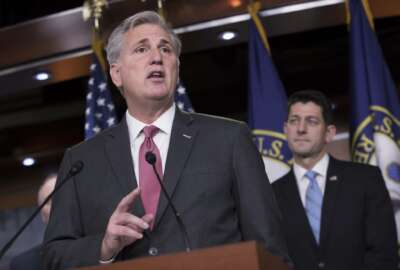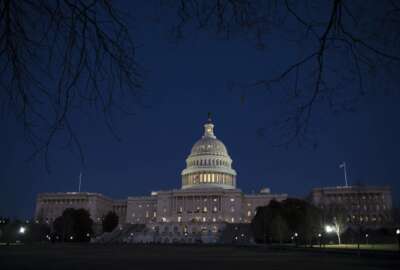
House passes defense budget, CR for civilian agencies through March 23
The House passed a six-week extension for civilian agencies and full-year appropriations for the Defense Department. The Senate is nearing a two-year spending c...
Subscribe to Federal Drive’s daily audio interviews on iTunes or PodcastOne.
The House on Tuesday passed a fifth continuing resolution for fiscal 2018, with a 245-182 vote.
This time, the CR includes full appropriations for the Defense Department but would carry over current funding levels for non-defense agencies through March 23.
Congress has through Feb. 8 to find some sort of budgetary solution and keep the government open past midnight on Friday.
This CR, however, differs significantly from the previous four resolutions.
Most notably, the House bill contains a $659 billion, full-year budget for the Pentagon, including $584 billion in base spending and an additional $75 billion for Overseas Contingency Operations.
“We will put on the bill that we passed on appropriations dealing with DoD back in September on to the continuing resolution, a place we do not want to be,” House Majority Leader Kevin McCarthy (R-Calif.) said during a Tuesday morning press conference. “We want government to be fully funded. We do not think this is the best way to fund government, and we will send that to the Senate.”
The CR also contains funding for the Census Bureau to continue its work on the 2020 count. Specifically, the bill includes up to $1.2 billion for the agency to “maintain the schedule and deliver the required data according to statutory deadlines in the 2020 Decennial Census Program,” the legislation said.
The Small Business Administration would also receive $225 million to continue issuing disaster loans and other types of assistance to the areas impacted by the 2017 hurricanes and wildfires.
The Trump administration said it would support the House CR, which essentially lifts the defense appropriations bill the chamber passed earlier this year. Notably, that bill includes a 2.4 percent pay raise for members of the military.
“The administration supports continuing discussions over a two-year budget agreement that ensures funding for national defense and other priorities,” the Office of Management Budget wrote in a statement of administration policy. “As those discussions continue, however, it is dangerous to hold defense funding for the current fiscal year hostage to arbitrary demands for lower-priority domestic programs.”
The House CR won’t likely face the same fate in the Senate. The chamber needs at least 60 votes to pass the CR, and Senate Democrats have insisted budget boosts for both the Pentagon and domestic agencies advance simultaneously.
Pairing the Pentagon’s budget with only temporary money for the rest of the government wouldn’t go anywhere in the Senate, vowed Minority Leader Chuck Schumer (D-N.Y.), who said it “would be barreling head first into a dead-end.”
Schumer and Senate Majority Leader Mitch McConnell (R-Ky.) appear to be working toward a plan that would respond to the House bill with a long-awaited spending pact to give whopping increases both to the Pentagon and domestic programs — an almost $300 billion spread over two years.
Talks in the Senate on such a framework appeared to intensify in hopes of an agreement this week, aides and lawmakers said, and the House GOP strategy appeared designed in part to invite the Senate to complete budget negotiations and use the temporary spending bill to advance such a budget agreement.
A broad-brush agreement to increase legally binding spending “caps” — which would otherwise keep the budgets for Pentagon and domestic agencies both essentially frozen — would be approved, then followed by a far more detailed catchall spending bill that would takes weeks to negotiate.
President Donald Trump may have complicated the matters. In a meeting with lawmakers, homeland security and law enforcement officials Tuesday afternoon, Trump said he’d “love to see a shutdown” if Democrats refuse to back his immigration proposal.
“If we have to shut it down because the Democrats don’t want safety, let’s shut it down,” Trump said during Tuesday’s meeting.
Rep. Barbara Comstock (R-Va.) voiced her disagreement in the meeting, according to White House pool reports.
This isn’t the first time the president expressed an interest in closing the government over an immigration impasse. Trump tweeted a similar sentiment last May and in August threatened the possibility of a shutdown over funding for the construction of a wall along the southern border.
House Minority Whip Steny Hoyer (D-Md.) said last week he would be surprised if the government shut down again. Local federal contractors told Hoyer that a string of continuing resolutions and a three-day partial government shutdown have already cost them time, money and talent.
But perhaps having four and possibly five continuing resolutions one-third of the way through the current fiscal year isn’t so abnormal.
Members of Congress have cleared 34 different continuing resolutions in the past seven years, and the majority of sitting lawmakers haven’t passed a budget in “regular order” once during their tenure.
And Congress hasn’t passed all 12 required appropriations bills since 1997, Sen. Rand Paul, chairman of the Homeland Security and Governmental Affairs Federal Spending Oversight and Emergency Management Subcommittee, said during Tuesday’s hearing on recent budgetary practices.
Budget experts expressed a similar frustrated Tuesday afternoon in a hearing before Paul’s subcommittee.
Short and long term continuing resolutions have had a variety of impacts on federal agencies, Heather Krause, director of strategic issues at the Government Accountability Office, told the subcommittee.
“Shorter and more numerous CRs can lead to more repetitive work,” she said. “This includes having to enter into short-term contracts or grants to reflect the duration of a CR. On the other hand, longer CRs can allow for better planning in the near term. However, they can lead agencies to rush to obligate funds late in the fiscal year. Agency officials told us that following a lengthy CR, they can end up spending funds or lower priority items that can be procured quickly if they don’t have enough time to spend funds on higher priority needs.”
Meanwhile, Paul is advocating for automatic continuing resolutions, which would fund agencies at 99 percent of the previous year’s budget until Congress approves a new appropriations bill after the start of the new fiscal year.
“What should make this a win-win for everyone is that agencies will have at least a minimum level of certainty,” Paul said. “Government won’t completely shut down; they’ll keep spending money. But there will be a penalty. [Agencies] will spend 1 percent less, and around here, spending 1 percent less ought to be enough of a penalty to get everyone to do their job and do the appropriations bills on time.”
Paul’s bill, the Government Shutdown Prevention Act, got approval from the budget experts from the Brookings Institution and Committee for a Responsible Federal Budget during Tuesday’s hearing.
They also suggested other “punishments,” such as canceling congressional recess periods if lawmakers fail to pass appropriations bills or forcing members to remain in the Senate chamber during a government shutdown.
The Associated Press contributed to this story.
Copyright © 2024 Federal News Network. All rights reserved. This website is not intended for users located within the European Economic Area.
Nicole Ogrysko is a reporter for Federal News Network focusing on the federal workforce and federal pay and benefits.
Follow @nogryskoWFED
Related Stories





